Financial Accounting Report: Final Accounts and Reconciliation
VerifiedAdded on 2020/10/22
|13
|2049
|448
Report
AI Summary
This report provides a comprehensive overview of financial accounting principles, focusing on the preparation and analysis of financial statements for both sole traders and companies. It begins by demonstrating the creation of income statements and balance sheets from trial balances, highlighting the importance of financial statements in assessing a business's financial health. The report then delves into bank reconciliation statements, explaining their purpose in rectifying discrepancies between a company's records and bank statements, along with key terms like deposits in transit and outstanding checks. Finally, it discusses the reconciliation of suspense and control accounts, emphasizing their roles in managing and classifying financial transactions, particularly in large organizations with numerous daily transactions. The report includes practical examples and working notes to illustrate the concepts discussed.
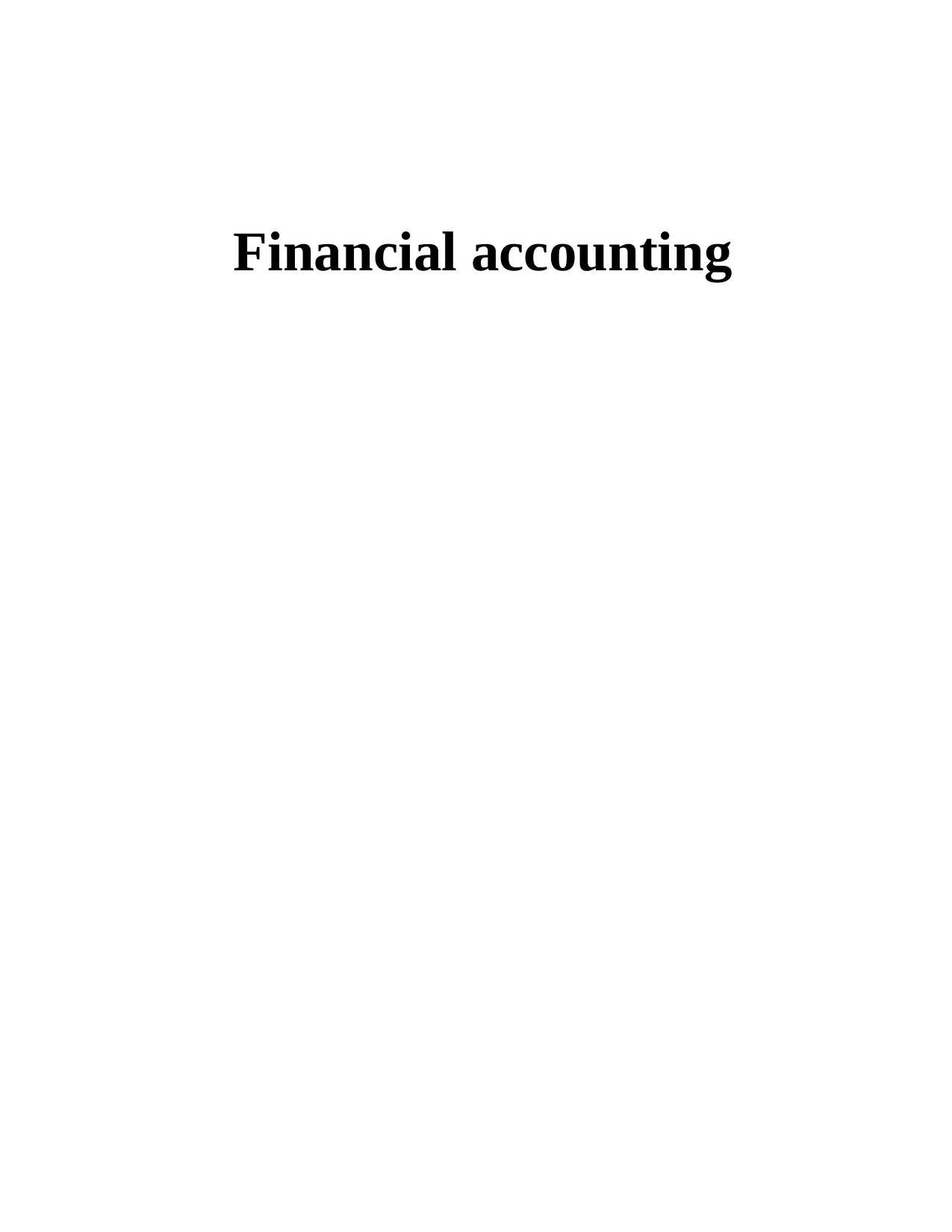
Financial accounting
Paraphrase This Document
Need a fresh take? Get an instant paraphrase of this document with our AI Paraphraser
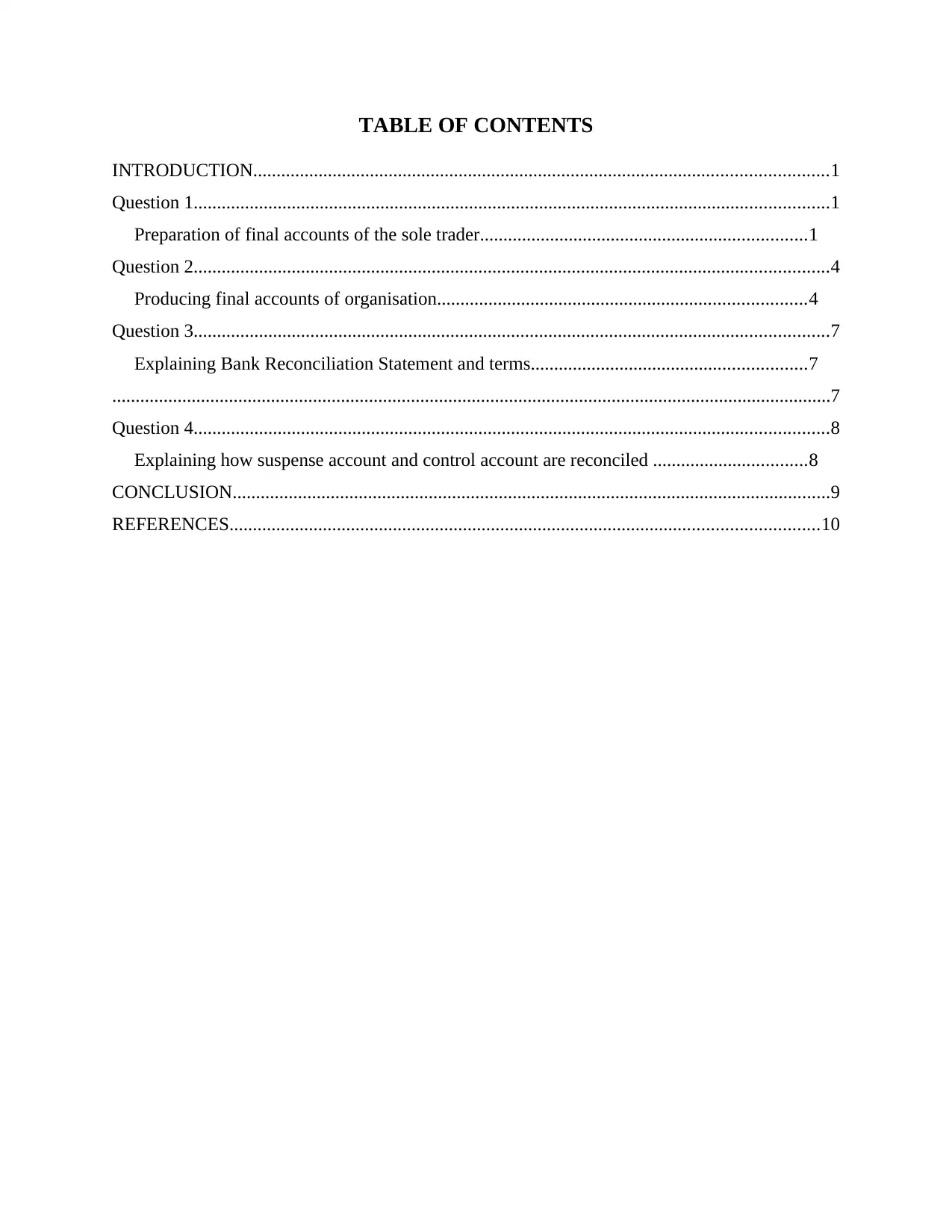
TABLE OF CONTENTS
INTRODUCTION...........................................................................................................................1
Question 1........................................................................................................................................1
Preparation of final accounts of the sole trader......................................................................1
Question 2........................................................................................................................................4
Producing final accounts of organisation...............................................................................4
Question 3........................................................................................................................................7
Explaining Bank Reconciliation Statement and terms...........................................................7
..........................................................................................................................................................7
Question 4........................................................................................................................................8
Explaining how suspense account and control account are reconciled .................................8
CONCLUSION................................................................................................................................9
REFERENCES..............................................................................................................................10
INTRODUCTION...........................................................................................................................1
Question 1........................................................................................................................................1
Preparation of final accounts of the sole trader......................................................................1
Question 2........................................................................................................................................4
Producing final accounts of organisation...............................................................................4
Question 3........................................................................................................................................7
Explaining Bank Reconciliation Statement and terms...........................................................7
..........................................................................................................................................................7
Question 4........................................................................................................................................8
Explaining how suspense account and control account are reconciled .................................8
CONCLUSION................................................................................................................................9
REFERENCES..............................................................................................................................10
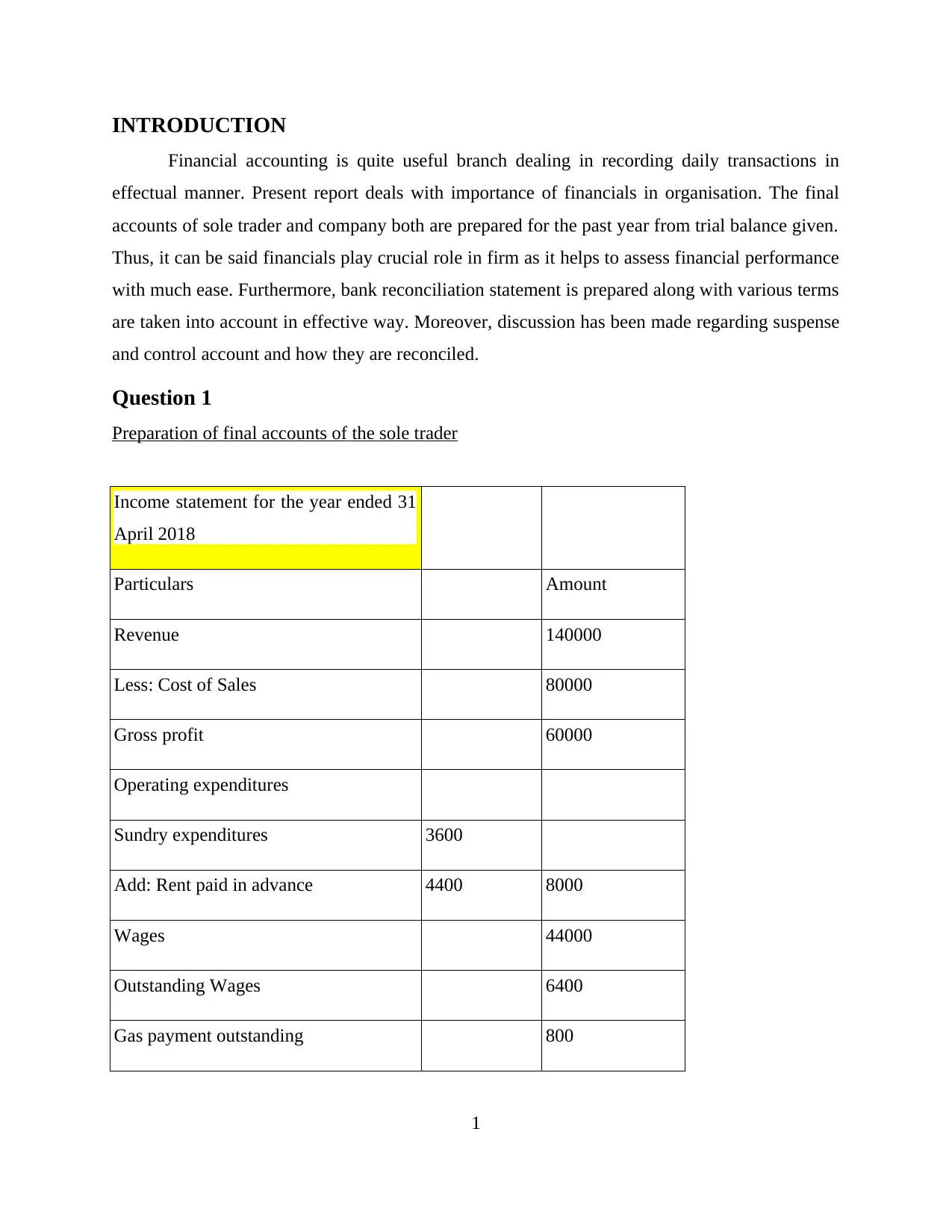
INTRODUCTION
Financial accounting is quite useful branch dealing in recording daily transactions in
effectual manner. Present report deals with importance of financials in organisation. The final
accounts of sole trader and company both are prepared for the past year from trial balance given.
Thus, it can be said financials play crucial role in firm as it helps to assess financial performance
with much ease. Furthermore, bank reconciliation statement is prepared along with various terms
are taken into account in effective way. Moreover, discussion has been made regarding suspense
and control account and how they are reconciled.
Question 1
Preparation of final accounts of the sole trader
Income statement for the year ended 31
April 2018
Particulars Amount
Revenue 140000
Less: Cost of Sales 80000
Gross profit 60000
Operating expenditures
Sundry expenditures 3600
Add: Rent paid in advance 4400 8000
Wages 44000
Outstanding Wages 6400
Gas payment outstanding 800
1
Financial accounting is quite useful branch dealing in recording daily transactions in
effectual manner. Present report deals with importance of financials in organisation. The final
accounts of sole trader and company both are prepared for the past year from trial balance given.
Thus, it can be said financials play crucial role in firm as it helps to assess financial performance
with much ease. Furthermore, bank reconciliation statement is prepared along with various terms
are taken into account in effective way. Moreover, discussion has been made regarding suspense
and control account and how they are reconciled.
Question 1
Preparation of final accounts of the sole trader
Income statement for the year ended 31
April 2018
Particulars Amount
Revenue 140000
Less: Cost of Sales 80000
Gross profit 60000
Operating expenditures
Sundry expenditures 3600
Add: Rent paid in advance 4400 8000
Wages 44000
Outstanding Wages 6400
Gas payment outstanding 800
1
⊘ This is a preview!⊘
Do you want full access?
Subscribe today to unlock all pages.

Trusted by 1+ million students worldwide
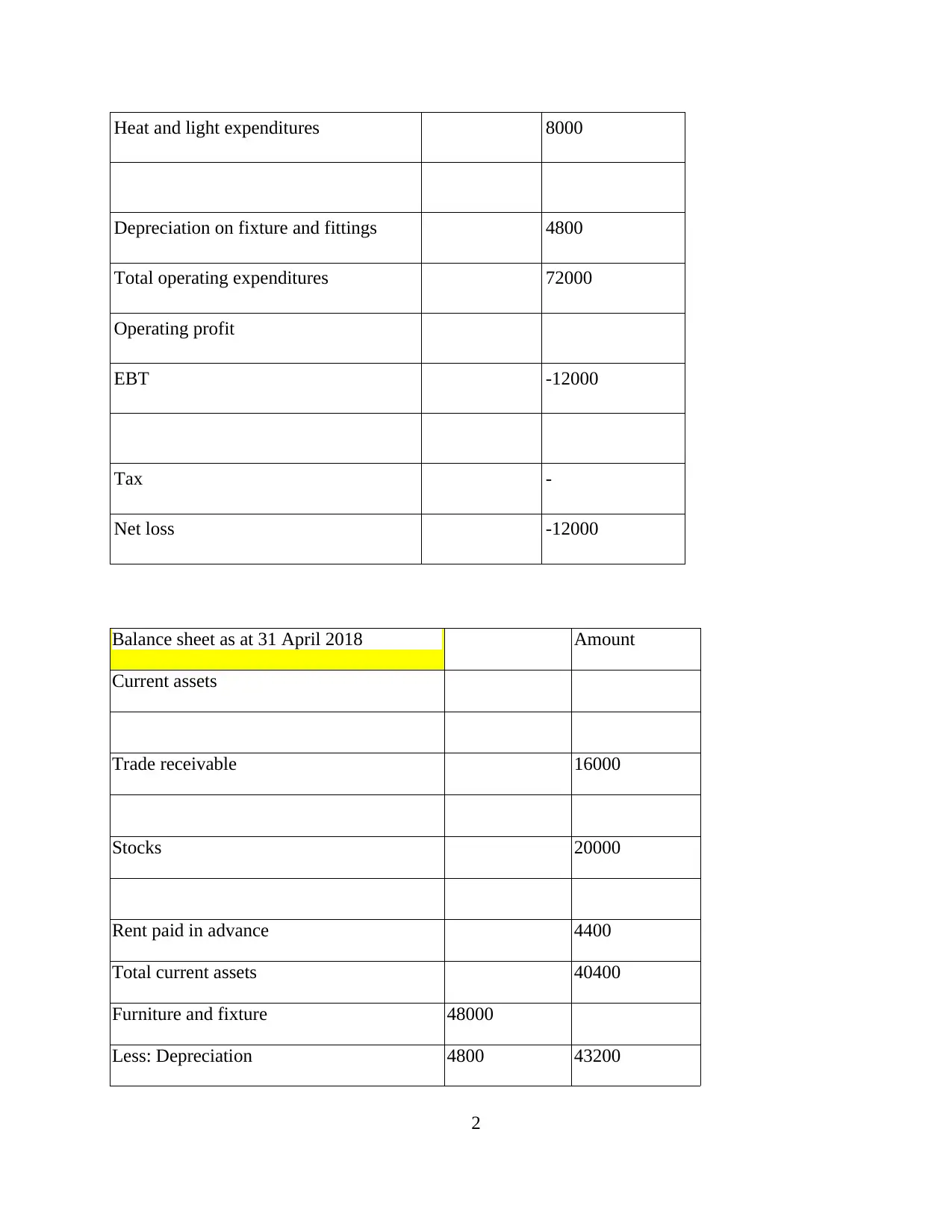
Heat and light expenditures 8000
Depreciation on fixture and fittings 4800
Total operating expenditures 72000
Operating profit
EBT -12000
Tax -
Net loss -12000
Balance sheet as at 31 April 2018 Amount
Current assets
Trade receivable 16000
Stocks 20000
Rent paid in advance 4400
Total current assets 40400
Furniture and fixture 48000
Less: Depreciation 4800 43200
2
Depreciation on fixture and fittings 4800
Total operating expenditures 72000
Operating profit
EBT -12000
Tax -
Net loss -12000
Balance sheet as at 31 April 2018 Amount
Current assets
Trade receivable 16000
Stocks 20000
Rent paid in advance 4400
Total current assets 40400
Furniture and fixture 48000
Less: Depreciation 4800 43200
2
Paraphrase This Document
Need a fresh take? Get an instant paraphrase of this document with our AI Paraphraser
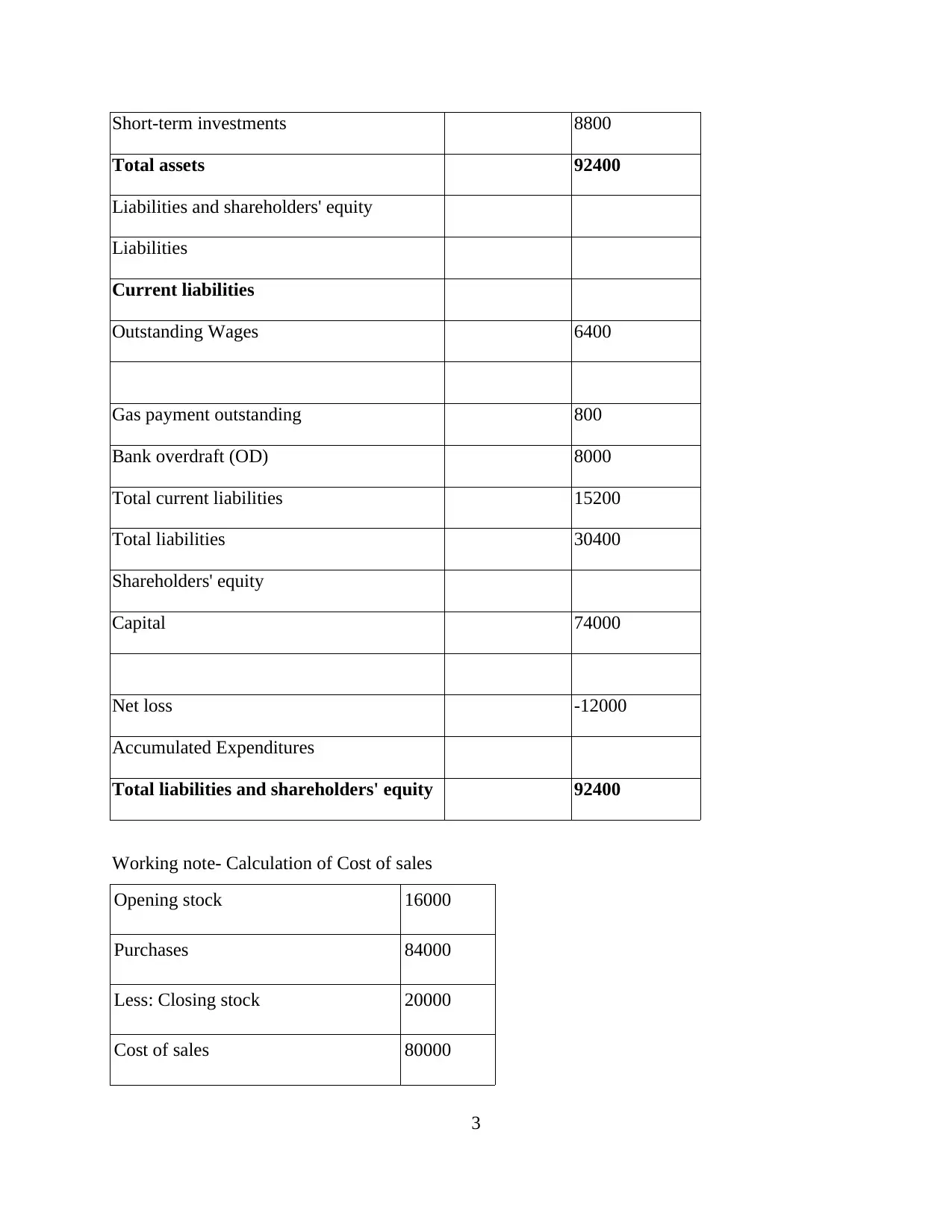
Short-term investments 8800
Total assets 92400
Liabilities and shareholders' equity
Liabilities
Current liabilities
Outstanding Wages 6400
Gas payment outstanding 800
Bank overdraft (OD) 8000
Total current liabilities 15200
Total liabilities 30400
Shareholders' equity
Capital 74000
Net loss -12000
Accumulated Expenditures
Total liabilities and shareholders' equity 92400
Working note- Calculation of Cost of sales
Opening stock 16000
Purchases 84000
Less: Closing stock 20000
Cost of sales 80000
3
Total assets 92400
Liabilities and shareholders' equity
Liabilities
Current liabilities
Outstanding Wages 6400
Gas payment outstanding 800
Bank overdraft (OD) 8000
Total current liabilities 15200
Total liabilities 30400
Shareholders' equity
Capital 74000
Net loss -12000
Accumulated Expenditures
Total liabilities and shareholders' equity 92400
Working note- Calculation of Cost of sales
Opening stock 16000
Purchases 84000
Less: Closing stock 20000
Cost of sales 80000
3
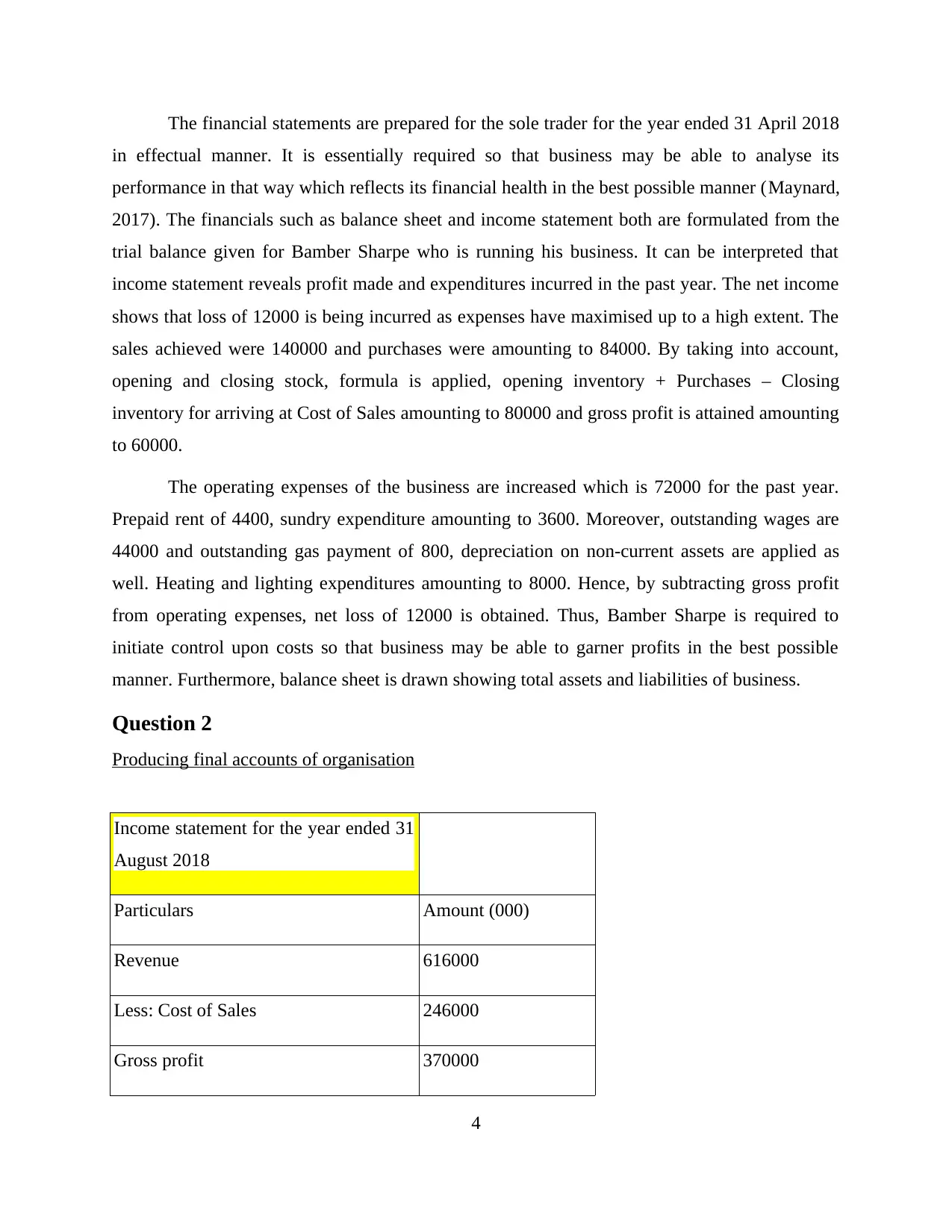
The financial statements are prepared for the sole trader for the year ended 31 April 2018
in effectual manner. It is essentially required so that business may be able to analyse its
performance in that way which reflects its financial health in the best possible manner (Maynard,
2017). The financials such as balance sheet and income statement both are formulated from the
trial balance given for Bamber Sharpe who is running his business. It can be interpreted that
income statement reveals profit made and expenditures incurred in the past year. The net income
shows that loss of 12000 is being incurred as expenses have maximised up to a high extent. The
sales achieved were 140000 and purchases were amounting to 84000. By taking into account,
opening and closing stock, formula is applied, opening inventory + Purchases – Closing
inventory for arriving at Cost of Sales amounting to 80000 and gross profit is attained amounting
to 60000.
The operating expenses of the business are increased which is 72000 for the past year.
Prepaid rent of 4400, sundry expenditure amounting to 3600. Moreover, outstanding wages are
44000 and outstanding gas payment of 800, depreciation on non-current assets are applied as
well. Heating and lighting expenditures amounting to 8000. Hence, by subtracting gross profit
from operating expenses, net loss of 12000 is obtained. Thus, Bamber Sharpe is required to
initiate control upon costs so that business may be able to garner profits in the best possible
manner. Furthermore, balance sheet is drawn showing total assets and liabilities of business.
Question 2
Producing final accounts of organisation
Income statement for the year ended 31
August 2018
Particulars Amount (000)
Revenue 616000
Less: Cost of Sales 246000
Gross profit 370000
4
in effectual manner. It is essentially required so that business may be able to analyse its
performance in that way which reflects its financial health in the best possible manner (Maynard,
2017). The financials such as balance sheet and income statement both are formulated from the
trial balance given for Bamber Sharpe who is running his business. It can be interpreted that
income statement reveals profit made and expenditures incurred in the past year. The net income
shows that loss of 12000 is being incurred as expenses have maximised up to a high extent. The
sales achieved were 140000 and purchases were amounting to 84000. By taking into account,
opening and closing stock, formula is applied, opening inventory + Purchases – Closing
inventory for arriving at Cost of Sales amounting to 80000 and gross profit is attained amounting
to 60000.
The operating expenses of the business are increased which is 72000 for the past year.
Prepaid rent of 4400, sundry expenditure amounting to 3600. Moreover, outstanding wages are
44000 and outstanding gas payment of 800, depreciation on non-current assets are applied as
well. Heating and lighting expenditures amounting to 8000. Hence, by subtracting gross profit
from operating expenses, net loss of 12000 is obtained. Thus, Bamber Sharpe is required to
initiate control upon costs so that business may be able to garner profits in the best possible
manner. Furthermore, balance sheet is drawn showing total assets and liabilities of business.
Question 2
Producing final accounts of organisation
Income statement for the year ended 31
August 2018
Particulars Amount (000)
Revenue 616000
Less: Cost of Sales 246000
Gross profit 370000
4
⊘ This is a preview!⊘
Do you want full access?
Subscribe today to unlock all pages.

Trusted by 1+ million students worldwide
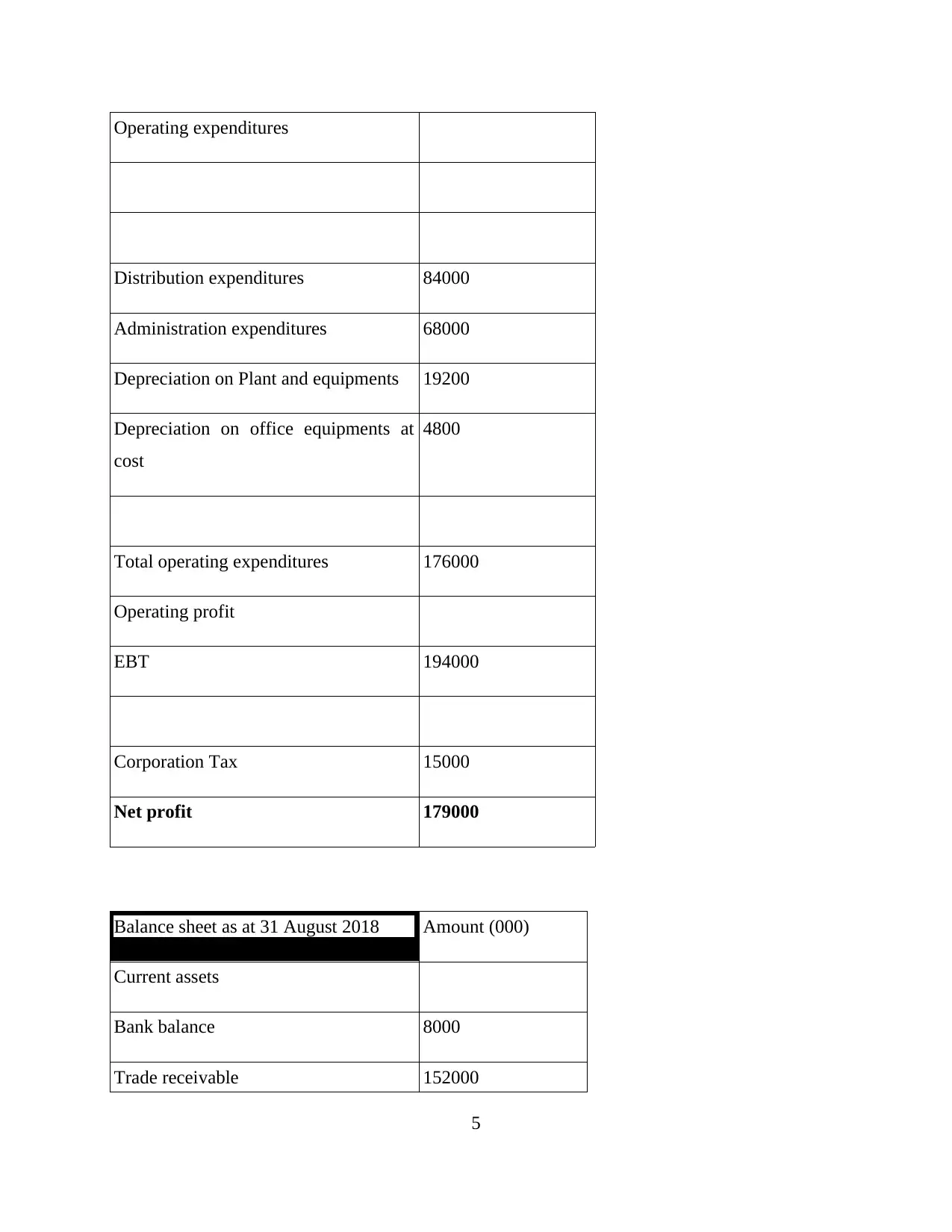
Operating expenditures
Distribution expenditures 84000
Administration expenditures 68000
Depreciation on Plant and equipments 19200
Depreciation on office equipments at
cost
4800
Total operating expenditures 176000
Operating profit
EBT 194000
Corporation Tax 15000
Net profit 179000
Balance sheet as at 31 August 2018 Amount (000)
Current assets
Bank balance 8000
Trade receivable 152000
5
Distribution expenditures 84000
Administration expenditures 68000
Depreciation on Plant and equipments 19200
Depreciation on office equipments at
cost
4800
Total operating expenditures 176000
Operating profit
EBT 194000
Corporation Tax 15000
Net profit 179000
Balance sheet as at 31 August 2018 Amount (000)
Current assets
Bank balance 8000
Trade receivable 152000
5
Paraphrase This Document
Need a fresh take? Get an instant paraphrase of this document with our AI Paraphraser
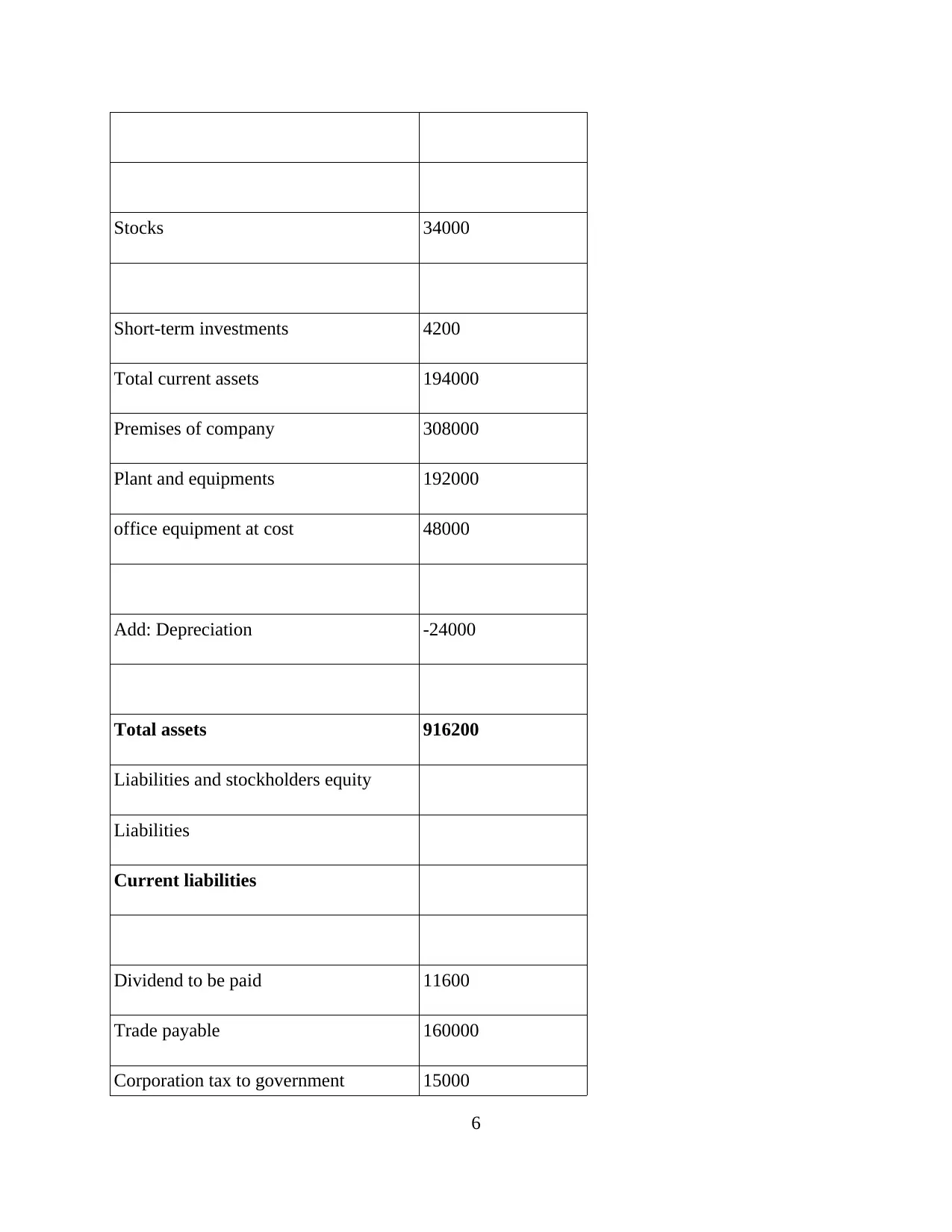
Stocks 34000
Short-term investments 4200
Total current assets 194000
Premises of company 308000
Plant and equipments 192000
office equipment at cost 48000
Add: Depreciation -24000
Total assets 916200
Liabilities and stockholders equity
Liabilities
Current liabilities
Dividend to be paid 11600
Trade payable 160000
Corporation tax to government 15000
6
Short-term investments 4200
Total current assets 194000
Premises of company 308000
Plant and equipments 192000
office equipment at cost 48000
Add: Depreciation -24000
Total assets 916200
Liabilities and stockholders equity
Liabilities
Current liabilities
Dividend to be paid 11600
Trade payable 160000
Corporation tax to government 15000
6
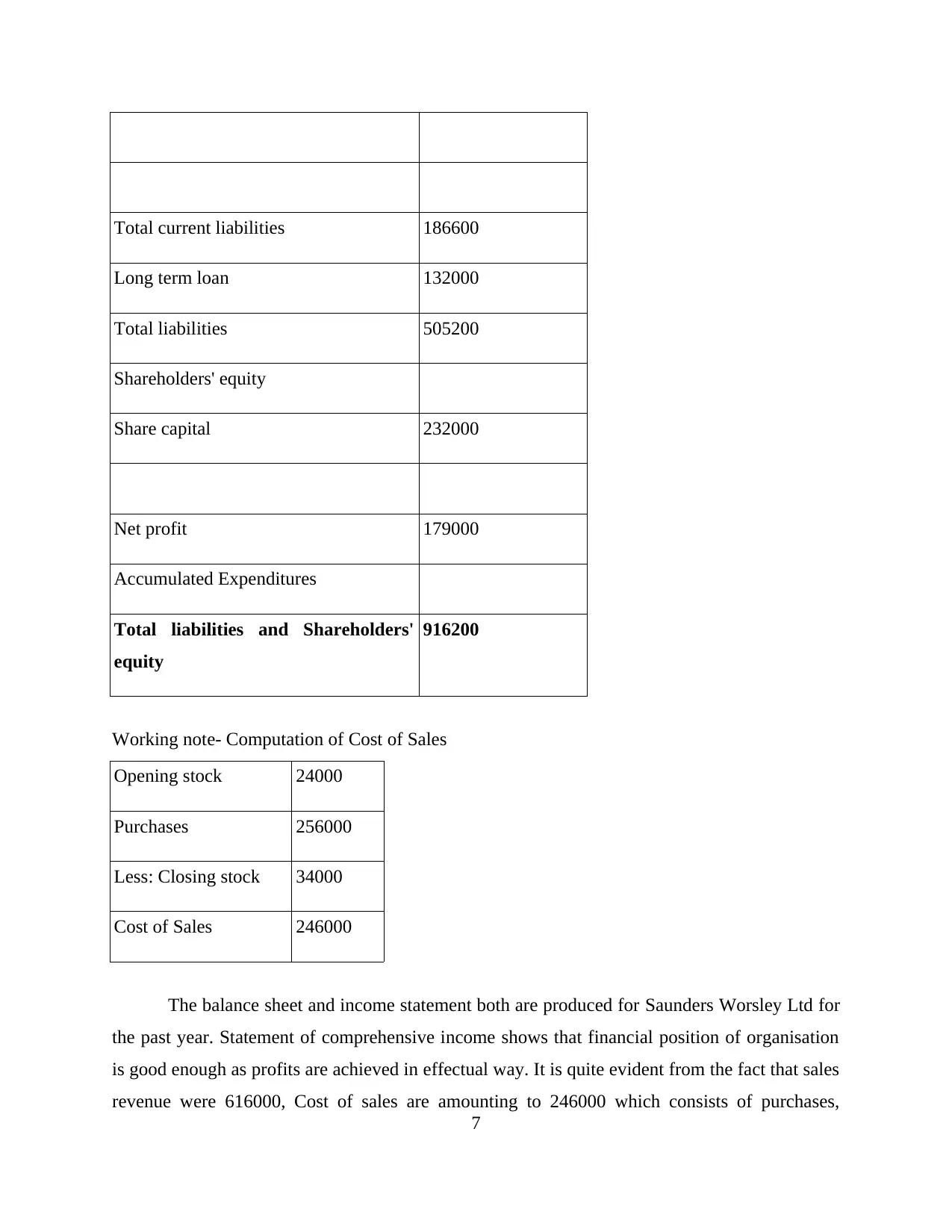
Total current liabilities 186600
Long term loan 132000
Total liabilities 505200
Shareholders' equity
Share capital 232000
Net profit 179000
Accumulated Expenditures
Total liabilities and Shareholders'
equity
916200
Working note- Computation of Cost of Sales
Opening stock 24000
Purchases 256000
Less: Closing stock 34000
Cost of Sales 246000
The balance sheet and income statement both are produced for Saunders Worsley Ltd for
the past year. Statement of comprehensive income shows that financial position of organisation
is good enough as profits are achieved in effectual way. It is quite evident from the fact that sales
revenue were 616000, Cost of sales are amounting to 246000 which consists of purchases,
7
Long term loan 132000
Total liabilities 505200
Shareholders' equity
Share capital 232000
Net profit 179000
Accumulated Expenditures
Total liabilities and Shareholders'
equity
916200
Working note- Computation of Cost of Sales
Opening stock 24000
Purchases 256000
Less: Closing stock 34000
Cost of Sales 246000
The balance sheet and income statement both are produced for Saunders Worsley Ltd for
the past year. Statement of comprehensive income shows that financial position of organisation
is good enough as profits are achieved in effectual way. It is quite evident from the fact that sales
revenue were 616000, Cost of sales are amounting to 246000 which consists of purchases,
7
⊘ This is a preview!⊘
Do you want full access?
Subscribe today to unlock all pages.

Trusted by 1+ million students worldwide
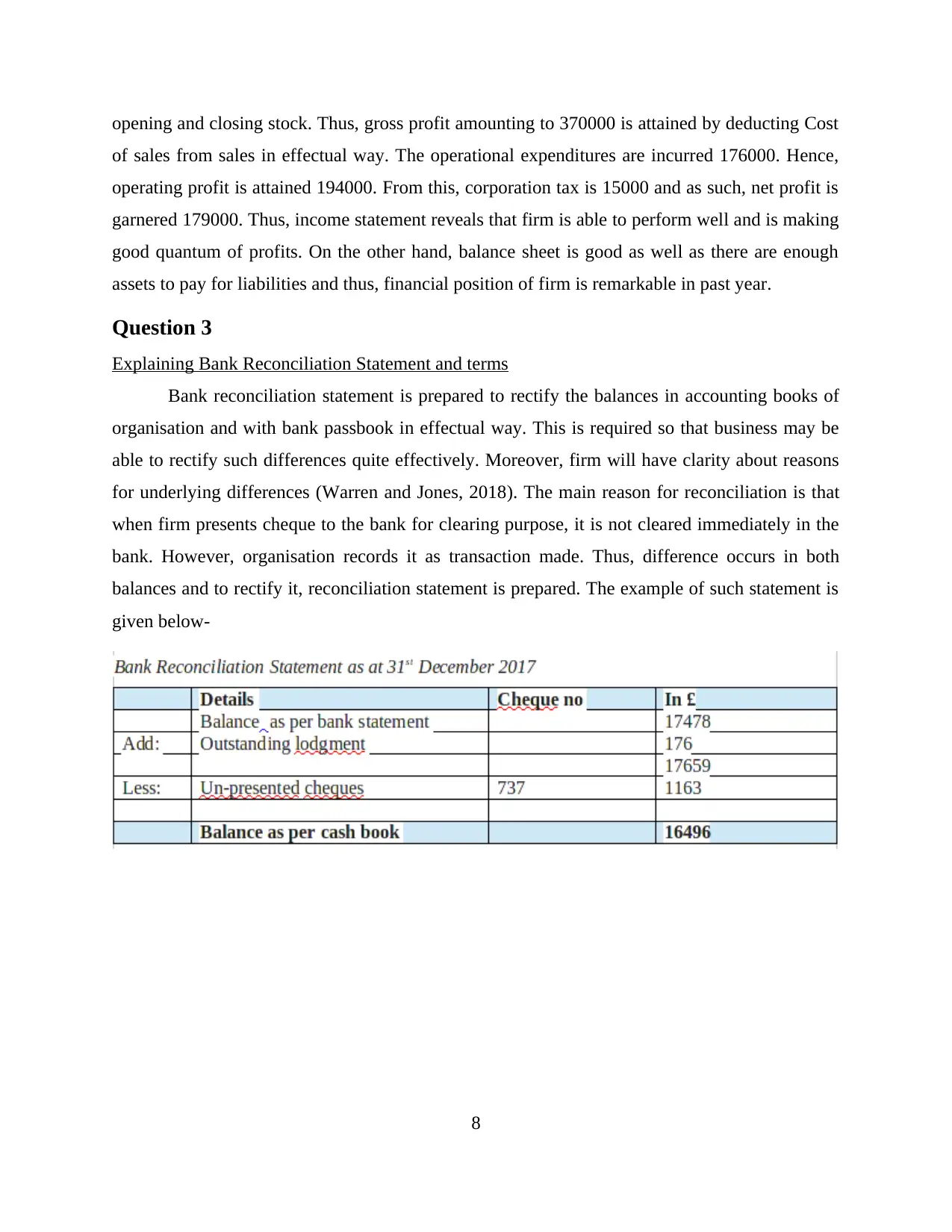
opening and closing stock. Thus, gross profit amounting to 370000 is attained by deducting Cost
of sales from sales in effectual way. The operational expenditures are incurred 176000. Hence,
operating profit is attained 194000. From this, corporation tax is 15000 and as such, net profit is
garnered 179000. Thus, income statement reveals that firm is able to perform well and is making
good quantum of profits. On the other hand, balance sheet is good as well as there are enough
assets to pay for liabilities and thus, financial position of firm is remarkable in past year.
Question 3
Explaining Bank Reconciliation Statement and terms
Bank reconciliation statement is prepared to rectify the balances in accounting books of
organisation and with bank passbook in effectual way. This is required so that business may be
able to rectify such differences quite effectively. Moreover, firm will have clarity about reasons
for underlying differences (Warren and Jones, 2018). The main reason for reconciliation is that
when firm presents cheque to the bank for clearing purpose, it is not cleared immediately in the
bank. However, organisation records it as transaction made. Thus, difference occurs in both
balances and to rectify it, reconciliation statement is prepared. The example of such statement is
given below-
8
of sales from sales in effectual way. The operational expenditures are incurred 176000. Hence,
operating profit is attained 194000. From this, corporation tax is 15000 and as such, net profit is
garnered 179000. Thus, income statement reveals that firm is able to perform well and is making
good quantum of profits. On the other hand, balance sheet is good as well as there are enough
assets to pay for liabilities and thus, financial position of firm is remarkable in past year.
Question 3
Explaining Bank Reconciliation Statement and terms
Bank reconciliation statement is prepared to rectify the balances in accounting books of
organisation and with bank passbook in effectual way. This is required so that business may be
able to rectify such differences quite effectively. Moreover, firm will have clarity about reasons
for underlying differences (Warren and Jones, 2018). The main reason for reconciliation is that
when firm presents cheque to the bank for clearing purpose, it is not cleared immediately in the
bank. However, organisation records it as transaction made. Thus, difference occurs in both
balances and to rectify it, reconciliation statement is prepared. The example of such statement is
given below-
8
Paraphrase This Document
Need a fresh take? Get an instant paraphrase of this document with our AI Paraphraser
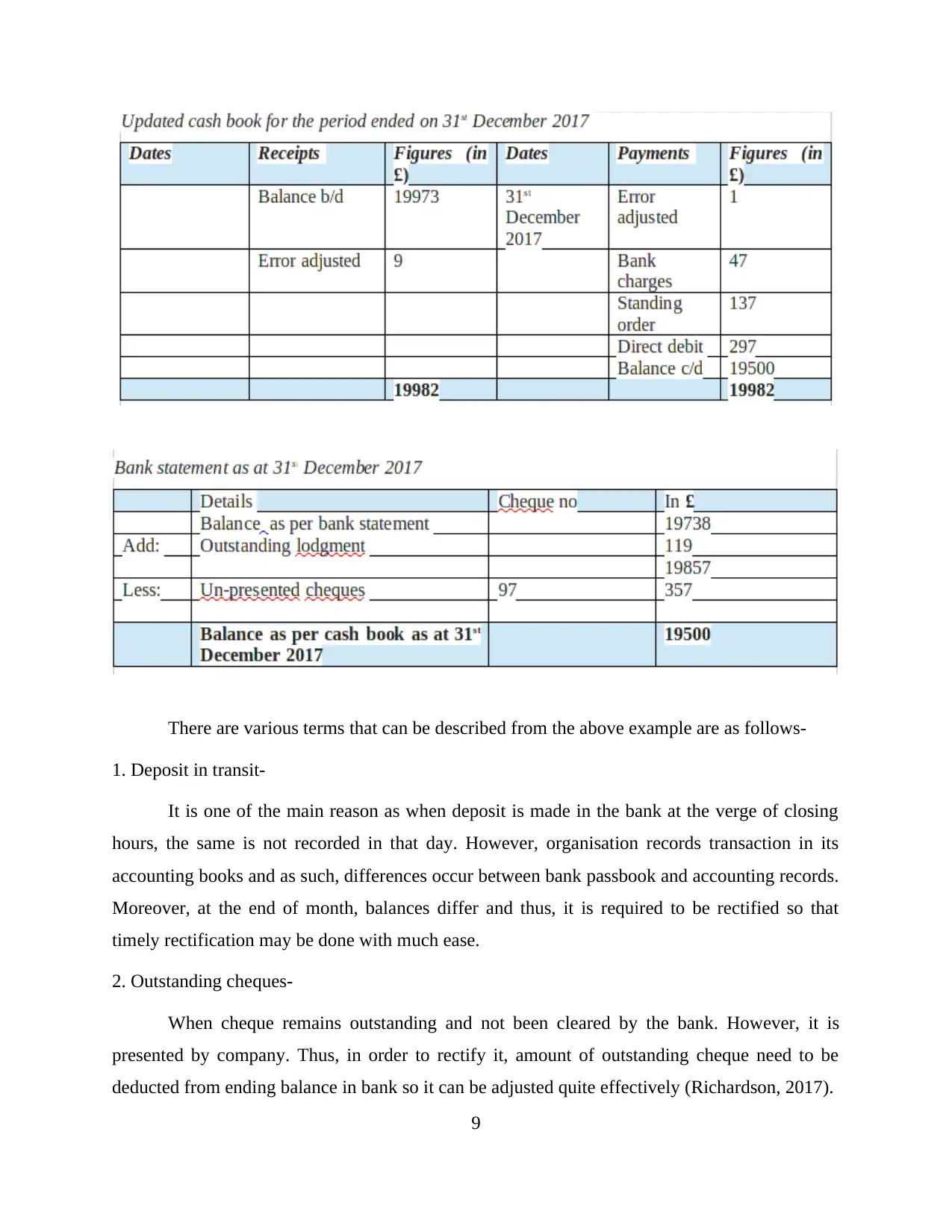
There are various terms that can be described from the above example are as follows-
1. Deposit in transit-
It is one of the main reason as when deposit is made in the bank at the verge of closing
hours, the same is not recorded in that day. However, organisation records transaction in its
accounting books and as such, differences occur between bank passbook and accounting records.
Moreover, at the end of month, balances differ and thus, it is required to be rectified so that
timely rectification may be done with much ease.
2. Outstanding cheques-
When cheque remains outstanding and not been cleared by the bank. However, it is
presented by company. Thus, in order to rectify it, amount of outstanding cheque need to be
deducted from ending balance in bank so it can be adjusted quite effectively (Richardson, 2017).
9
1. Deposit in transit-
It is one of the main reason as when deposit is made in the bank at the verge of closing
hours, the same is not recorded in that day. However, organisation records transaction in its
accounting books and as such, differences occur between bank passbook and accounting records.
Moreover, at the end of month, balances differ and thus, it is required to be rectified so that
timely rectification may be done with much ease.
2. Outstanding cheques-
When cheque remains outstanding and not been cleared by the bank. However, it is
presented by company. Thus, in order to rectify it, amount of outstanding cheque need to be
deducted from ending balance in bank so it can be adjusted quite effectively (Richardson, 2017).
9
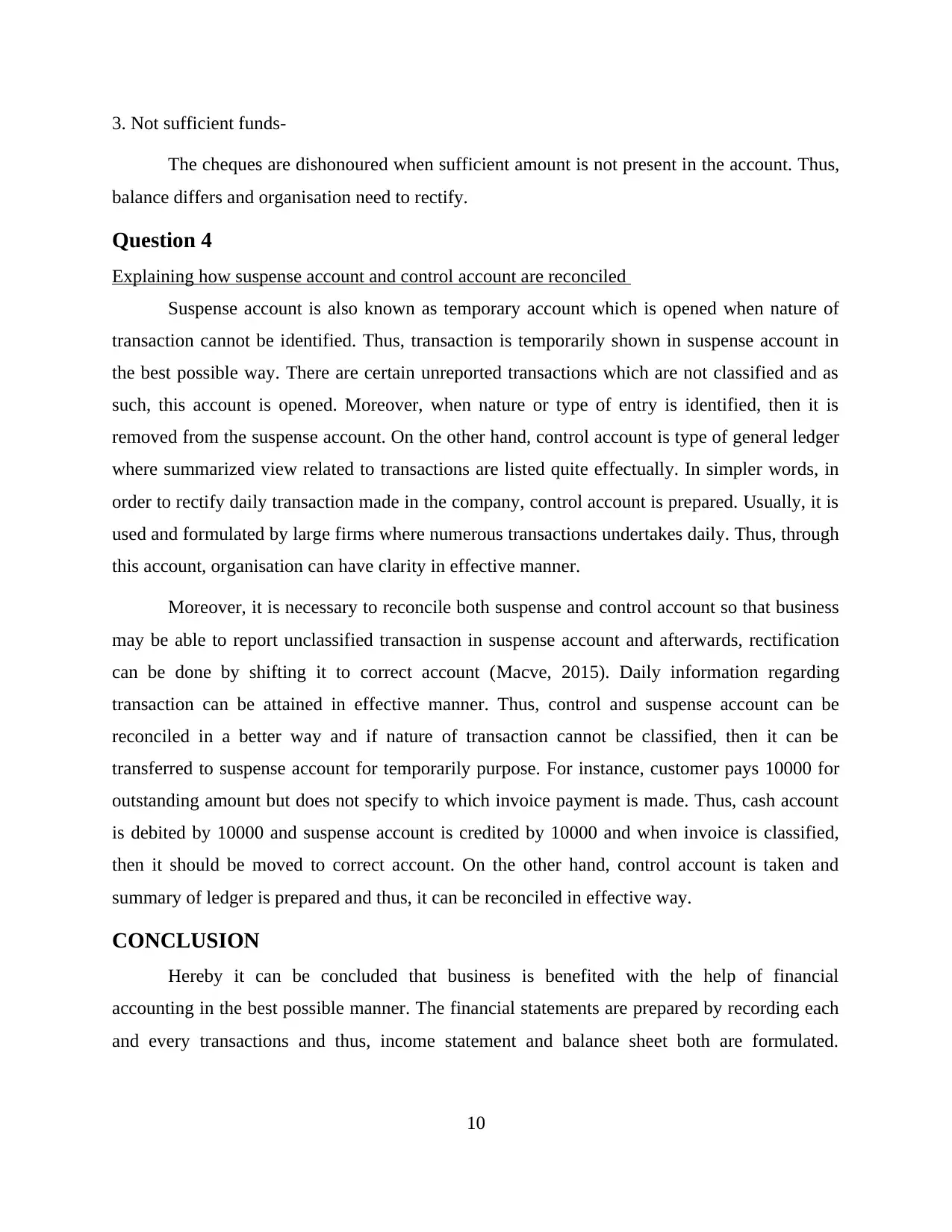
3. Not sufficient funds-
The cheques are dishonoured when sufficient amount is not present in the account. Thus,
balance differs and organisation need to rectify.
Question 4
Explaining how suspense account and control account are reconciled
Suspense account is also known as temporary account which is opened when nature of
transaction cannot be identified. Thus, transaction is temporarily shown in suspense account in
the best possible way. There are certain unreported transactions which are not classified and as
such, this account is opened. Moreover, when nature or type of entry is identified, then it is
removed from the suspense account. On the other hand, control account is type of general ledger
where summarized view related to transactions are listed quite effectually. In simpler words, in
order to rectify daily transaction made in the company, control account is prepared. Usually, it is
used and formulated by large firms where numerous transactions undertakes daily. Thus, through
this account, organisation can have clarity in effective manner.
Moreover, it is necessary to reconcile both suspense and control account so that business
may be able to report unclassified transaction in suspense account and afterwards, rectification
can be done by shifting it to correct account (Macve, 2015). Daily information regarding
transaction can be attained in effective manner. Thus, control and suspense account can be
reconciled in a better way and if nature of transaction cannot be classified, then it can be
transferred to suspense account for temporarily purpose. For instance, customer pays 10000 for
outstanding amount but does not specify to which invoice payment is made. Thus, cash account
is debited by 10000 and suspense account is credited by 10000 and when invoice is classified,
then it should be moved to correct account. On the other hand, control account is taken and
summary of ledger is prepared and thus, it can be reconciled in effective way.
CONCLUSION
Hereby it can be concluded that business is benefited with the help of financial
accounting in the best possible manner. The financial statements are prepared by recording each
and every transactions and thus, income statement and balance sheet both are formulated.
10
The cheques are dishonoured when sufficient amount is not present in the account. Thus,
balance differs and organisation need to rectify.
Question 4
Explaining how suspense account and control account are reconciled
Suspense account is also known as temporary account which is opened when nature of
transaction cannot be identified. Thus, transaction is temporarily shown in suspense account in
the best possible way. There are certain unreported transactions which are not classified and as
such, this account is opened. Moreover, when nature or type of entry is identified, then it is
removed from the suspense account. On the other hand, control account is type of general ledger
where summarized view related to transactions are listed quite effectually. In simpler words, in
order to rectify daily transaction made in the company, control account is prepared. Usually, it is
used and formulated by large firms where numerous transactions undertakes daily. Thus, through
this account, organisation can have clarity in effective manner.
Moreover, it is necessary to reconcile both suspense and control account so that business
may be able to report unclassified transaction in suspense account and afterwards, rectification
can be done by shifting it to correct account (Macve, 2015). Daily information regarding
transaction can be attained in effective manner. Thus, control and suspense account can be
reconciled in a better way and if nature of transaction cannot be classified, then it can be
transferred to suspense account for temporarily purpose. For instance, customer pays 10000 for
outstanding amount but does not specify to which invoice payment is made. Thus, cash account
is debited by 10000 and suspense account is credited by 10000 and when invoice is classified,
then it should be moved to correct account. On the other hand, control account is taken and
summary of ledger is prepared and thus, it can be reconciled in effective way.
CONCLUSION
Hereby it can be concluded that business is benefited with the help of financial
accounting in the best possible manner. The financial statements are prepared by recording each
and every transactions and thus, income statement and balance sheet both are formulated.
10
⊘ This is a preview!⊘
Do you want full access?
Subscribe today to unlock all pages.

Trusted by 1+ million students worldwide
1 out of 13
Related Documents
Your All-in-One AI-Powered Toolkit for Academic Success.
+13062052269
info@desklib.com
Available 24*7 on WhatsApp / Email
![[object Object]](/_next/static/media/star-bottom.7253800d.svg)
Unlock your academic potential
Copyright © 2020–2025 A2Z Services. All Rights Reserved. Developed and managed by ZUCOL.





